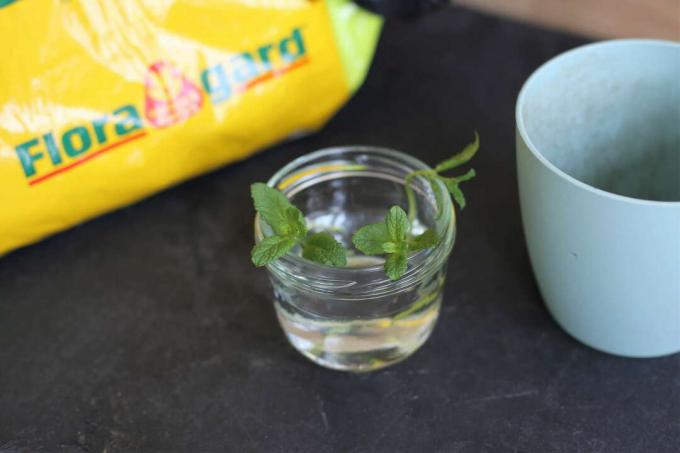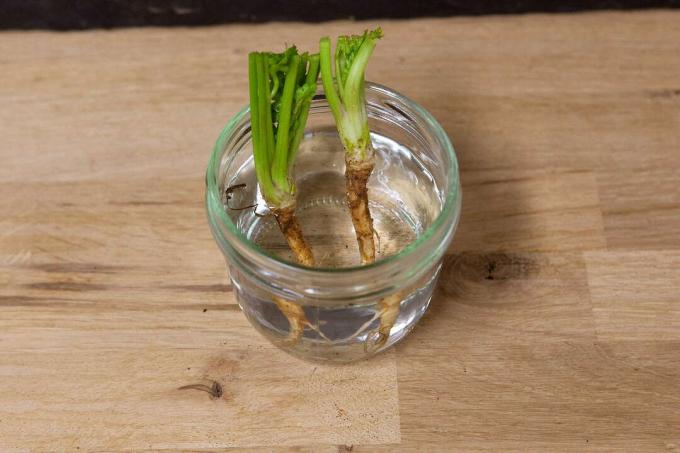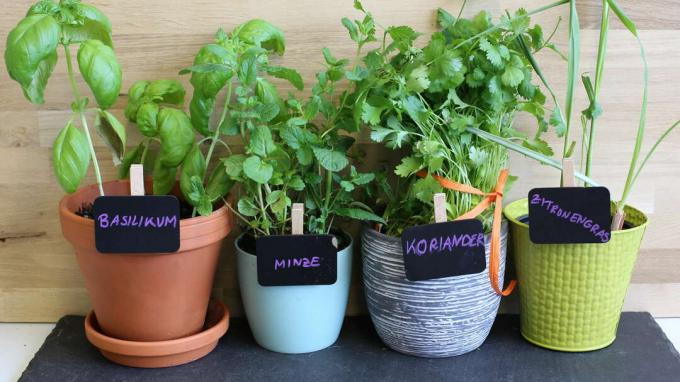Out of the supermarket and into the bin? No! We'll show you how to grow basil, mint, coriander & lemongrass easily at home.
Fresh herbs give many dishes the right kick. But often you only need one little thing, the rest ends up in the trash. It doesn't have to be! Many herbs can easily be regrowed in the pot. The reason: Most herbs can be easily propagated using cuttings. Although mint, coriander, basil and lemongrass look very different, they all have one thing in common: From the apparently disused old plant, new young plants can be created by cuttings breed. And that is not only very easy, it is also good for the environment and your wallet.
contents
- Let the basil grow back
- Let the mint grow back
- Let the coriander grow back
- Let lemongrass grow back
- Pro tips for herb regrowth
Let the basil grow back
What would Italian cuisine be without basil? But what do you do with the leftover herbs? The answer is very simple: You cut the shoot tips to a length of about 5 to 7 cm. Then remove the lower leaves and place the cuttings in water for about seven days. Here the basil cuttings form new roots. When these have a length of about 4 to 5 cm, they are ready to be planted. To do this, simply put the basil in the soil up to about 1 cm from the bottom pair of leaves and water it vigorously. Now all you need is a little patience and a little water from the watering can every now and then and your cutting will turn into a stately plant.

Here's a quick recap of how you can regrow basil:
- Cuttings from 5 – Cut off 7 cm in size
- Remove the lower leaves from the cuttings
- Put in water for 7 days
- Plant cuttings in a pot of potting soil
Let the mint grow back
In the mint the procedure is the same with the basil. First, the cuttings should be shortened to a length of 5 to 7 cm. Then remove the lower leaves, leaving only the first two to three pairs of leaves at the tip of the shoot. The remaining leaves form too large an evaporation surface for the plant and would ensure that it dries up and dies despite watering. Now the prepared cuttings can root in a glass of water. If the roots have developed sufficiently after about seven days, the cutting is ready for the pot. Here it can best be planted in moist, peat-free soil so that it soon grows and thrives.

Here's a quick summary of how you can regrow mint:
- The individual mint shoots to a length of 5 – Shorten by 7 cm
- Defoliate the lower part of the cuttings
- Put in water for about a week
- The cutting is ready to be planted
Let the coriander grow back
coriander Unlike basil or mint, it is propagated by root cuttings. Therefore, when cutting to a length of about 5 to 7 cm, it is not the roots that should be cut back, but the upper part of the plant including the leaves. As a rough direction, a cut about 2 cm above the area where the plant would leave the ground is ideal. After that, the plant should stand in fresh water for about seven days. If it has formed enough roots, the coriander can be planted again, preferably in a flower pot with peat-free soil.

Here's a quick summary of how you can regrow coriander:
- Coriander above the roots to a total length of 5 – Shorten by 7 cm
- Put in fresh water for about a week
- Plant in peat-free potting soil
Let lemongrass grow back
Similar to the coriander is also the Lemongrass not the tip of the shoot, but the lower part of the plant interesting. You should shorten this to a length of 2 to 4 cm and then place it in fresh water for a week. The lemongrass should take root here before it begins its journey into the earth. After the week is up, you can transplant the lemongrass cuttings into a pot of peat-free potting soil, with at least half of the cuttings above the ground.

Here's a quick recap of how you can regrow lemongrass:
- Lower part of the plant on 2 – Shorten by 4 cm
- Place in a container with water for about 7 days to root
- Planting, at least half of the plant should be above the ground
Pro tips for herb regrowth
If you want to make life easier for your herb cuttings, you can use a few tricks to help them. First of all, when choosing your cuttings, you should pay attention to the condition of the shoots. Severely wilted or even withered shoots often fail, despite great efforts, to get round the curve again and to mature into a new plant. Instead, you should choose the healthiest, strongest-looking shoots on your plant for propagation.
Once the cuttings have been cut, the following should be observed when rooting in the water glass: The optimal climate for cuttings is warm, preferably paired with high humidity. This can be easily achieved in so-called seed trays with a transparent cover, but a space on the window sill is sufficient in most cases. However, care should be taken to ensure that the cuttings are in partial shade, i.e. not exposed to the blazing sun. To stimulate root growth, the glass can be wrapped in aluminum foil to darken it. It is also important to change the water regularly. This provides the plant with new nutrients. If that's not enough, you can add a pinch of root activator to the water, but you should be careful not to overfertilize the young plants.

When planting, we recommend choosing potting soil. Due to its loose structure, it allows good root growth and stores water so that the cuttings are optimally supplied. At the same time, it is rather poor in nutrients, which stimulates the plants to promote their root growth in order to obtain other nutrients themselves. It is also important to water regularly after planting. Mediterranean herbs need less water than native herbs – on hot summer days it should still be watered up to twice. Waterlogging should be avoided in any case. Your herbs will stay fresh for a long time and enrich your kitchen.
Tips on how to regrow herbs quickly:
- Choose strong shoots for cuttings
- A warm climate, high humidity and partial shade are ideal
- Darken the glass to stimulate root growth
- Change water regularly
- Use potting soil when planting
- Water regularly even after planting (up to twice a day)
Vegetables can also be grown back quite easily. This article will tell you everything about the topic Regrowing.
I studied agricultural science and I am a real village child. At home I have a small vegetable garden that I tend and look after, and I prefer to spend the time outside. When I'm not outdoors, I love to write. My love is not only for plants and writing, but also especially for the animal world.
Favorite fruit: currants and raspberries.
Favorite vegetables: salsify, savoy cabbage and potatoes.
